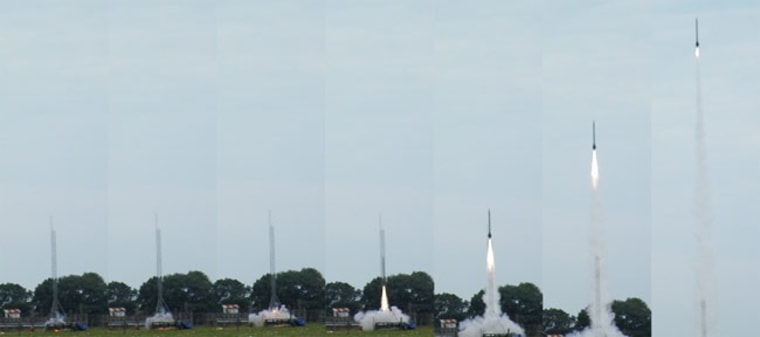Rocket propellant has barely changed in the more than 50 years since the launch of the first artificial satellite Sputnik. But a new mixture of nano-aluminum powder and frozen water could make rocket launches more environmentally friendly, and even allow spacecraft to refuel at distant locations such as the moon or Mars.
The aluminum-ice propellant known as ALICE gets its kick from a chemical reaction between water and aluminum. Researchers hope that the hydrogen products of that reaction might go beyond launching rockets, and also feed hydrogen fuel cells for long duration space missions.
"In the bigger picture, we're looking at technology that can store hydrogen long term," said Steven Son, a professor of mechanical engineering at Purdue University. "Water is a nice, stable way to store hydrogen."
Both NASA and the Air Force Office of Scientific Research have shown enough interest in the concept to fund initial rocket firing tests. The research teams at Purdue and Penn State University used ALICE to successfully launch a rocket to 1,300 feet during an August flight test.
Such technology may not see action for some years to come, or at least until NASA sorts out its space exploration plans. But the recent confirmation of water sources on the moon and Mars may hint at a future where ALICE and similar rocket propellants become highly practical.
Nano-aluminum arrives
Aluminum already represents a small but critical part of many rocket fuels, including the propellants for the space shuttle's solid booster rockets and NASA's next generation Ares rockets. The metal's high ignition temperature of more than 6,920 degrees Fahrenheit forces exhaust gases out at high velocity to propel rockets upward.
ALICE squeezes even more out of the aluminum by using nano-scale particles with diameters of 80 nanometers, or 500 times smaller than the width of a human hair. Such tiny particles combust more rapidly than larger particles to give an additional kick, and may allow easier control over a rocket's thrust.
"The nano-scale aluminum is really key to making system work," said Timothee Pourpoint, a professor in the school of aeronautics and astronautics at Purdue. "Using only micron-sized aluminum powder and water ice would not have worked."
Slideshow 12 photos
Month in Space: January 2014
Researchers have tossed around theoretical calculations of using just aluminum and water for rocket propellant in the past. But the Purdue and Penn State teams took advantage of the relatively new nano-aluminum to translate the concepts into reality.
"There have certainly been previous research efforts with nano-aluminum and water," Son told SPACE.com. "This effort is the first time that anyone has actually launched a rocket."
Ice might suffice
The aluminum burning at extreme temperatures represents just one part of the ALICE equation. The other includes the oxygen and hydrogen locked within water molecules that help feed the aluminum combustion.
That reaction produces products in the form of hydrogen gas and aluminum oxide, which may prove greener than existing rockets. Current space shuttle flights release about 230 tons of hydrochloric acid in the exhaust left behind by their solid rocket boosters.
Creating the proper mix of ALICE propellant proved tricky, but the researchers ended up with slurry that some describe as being like toothpaste.
"To produce an adequate mix, we wanted to mix it using a machine, not mix it by hand with a spatula," Son recalled. "If you're going to scale up propellant processing, you up have to automate the mixing."
The freezing helped keep the propellant intact during the first test launch, as well as prevent any premature aluminum-ice reactions caused by accidental sparks, or slow oxidation from occurring.
Moving on up
Success aside, the researchers have already turned their thoughts to the new ALICE mixtures that can boost performance beyond that of existing rockets.
"We're at or slightly below conventional solid propellants in terms of overall performance," Son noted. But he added that the team had made "conservative choices" to ensure that the first flight showing proof of concept went smoothly. Now they can push the envelope.
Perhaps the most immediate idea involves mixing nano-aluminum with larger aluminum particles. That could allow more efficient use of the aluminum, and cut back on the amount of wasted aluminum oxide in the initial aluminum.
The researchers are also working with more energetic aluminum-water mixtures as they initially chose a mixture with extra ice to err on the safe side. Their caution came at the cost of lower exhaust gas temperatures during launch, which translated into lower performance and less hydrogen produced.
"We are thinking about another launch with a different composition of aluminum-ice propellant," Pourpoint said. "We know we can adjust the ratio between the two components as well as add components to improve performance."
Future work might even look at creating gelled propellant that behaves like liquid fuel. New mixtures could also produce more hydrogen, and take a step closer to helping run hydrogen fuel cells.
But both Son and Pourpoint emphasized a more immediate benefit from ALICE — giving more than a dozen undergraduate and graduate students the chance to translate scientific concepts into a real rocket launch. Getting to help pioneer a future phase of space exploration doesn't hurt, either.

